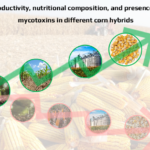Rosa Emilia Moraes, scientific journalist at Linceu Editorial, São José dos Campos, SP, Brazil.
 Weathering is the process of dissolving and breaking down of rocks, being triggered by physical, chemical, and biological agents on Earth’s surface, such as the action of water, climate, and the contact with salts and acids.
Weathering is the process of dissolving and breaking down of rocks, being triggered by physical, chemical, and biological agents on Earth’s surface, such as the action of water, climate, and the contact with salts and acids.
Plants can be agents of bioweathering due to the activity of their roots, the release of organic substances, and the associated microbial population. The weathering of rocks is usually slow, but the interaction between the minerals and the rhizosphere can accelerate this process. Biotite, a mineral present in rocks such as schists and syenites, shows a relatively fast dissolution rate, indicating the potential use of these rocks as a source of potassium for plants (MANNING, et al, 2017).
Due to the magnitude of agriculture within the global economic scenario, several studies have been conducted to evaluate the fertilizer potential of silicate minerals used as a source of nutrients, in the short term. In its volume 57, the journal Pesquisa Agropecuária Brasileira (PAB) presents the article Dissolution of silicate minerals and nutrient availability for corn grown successively developed by researchers of Universidade de Brasília (UnB) and Empresa Brasileira de Pesquisa Agropecuária (Embrapa).
Figure 1. Images obtained by scanning electron microscopy of the biotite grains used in the corn (Zea mays) growth experiments, showing biotite surface: A and B, before and after plant growth in biotite schist, respectively; and C and D, before and after plant growth in biotite syenite, respectively.
The article detailed the cultivation process of corn (Zea mays L.) in its hybrid variety 30F53VYHR, in pure and ground samples of biotite schist (BSC) and biotite syenite (BSY) obtained from different regions of Brazil to evaluate the availability of nutrients of these agrominerals. The research findings contribute to the understanding of the dissolution process, being of great relevance for the development of new options for remineralization and maintenance of agricultural soil fertility.
The research indicated that both BSC and BSY provided nutrients through congruent and incongruent dissolution; however, under the conditions of the study, BSC released more nutrients to the plants grown in pure and ground rock than BSY. The rock dust from BSC and BSY can also be considered a source of magnesium, a nutrient essential for plants, but scarce in some soil types such as those of the Cerrado (Brazilian Savanna) biome. The availability of these nutrients was related to the content of oxidizable iron and manganese in the structure of the biotite, chlorite, and clinopyroxene minerals, which are also rich in alkali and alkali earth cations.
The experiment was carried out in seven successive corn planting cycles. However, the nutrients were not fully released to the plants, as the dissolution of the rocks over the seven growth cycles was incomplete. Due to the small volume of the containers used and the low concentration of released nutrients, the growth of maize cultivated exclusively in ground rock was lower compared to that in properly corrected and fertilized soils. However, the dissolution of minerals is expected to be more effective when mixed with soils. Therefore, further research on plant growth in soils treated with silicate agrominerals is important.
References
MANNING, D.A.C., et al. Testing the ability of plants to access potassium from framework silicate minerals. Science of the Total Environment [online]. 2017, vol.574, pp.476-481 [viewed 20 January 2023]. https://doi.org/10.1016/j.scitotenv.2016.09.086. Available from: https://www.sciencedirect.com/science/article/abs/pii/S0048969716320058
To read the article, access
KRAHL, L.L., et al. Dissolution of silicate minerals and nutrient availability for corn grown successively. Pesq. agropec. bras. [online]. 2022, vol. 57, e01467 [viewed 20 January 2023]. https://doi.org/10.1590/S1678-3921.pab2022.v57.01467. Available from: https://www.scielo.br/j/pab/a/B8G3YqWx8zM9F8HyfhRksPt/
External links
Pesquisa Agropecuária Brasileira – PAB: https://www.scielo.br/pab/
Pesquisa Agropecuária Brasileira – site: www.embrapa.br/pab
Universidade de Brasília: http://fup.unb.br/
Como citar este post [ISO 690/2010]:














Recent Comments